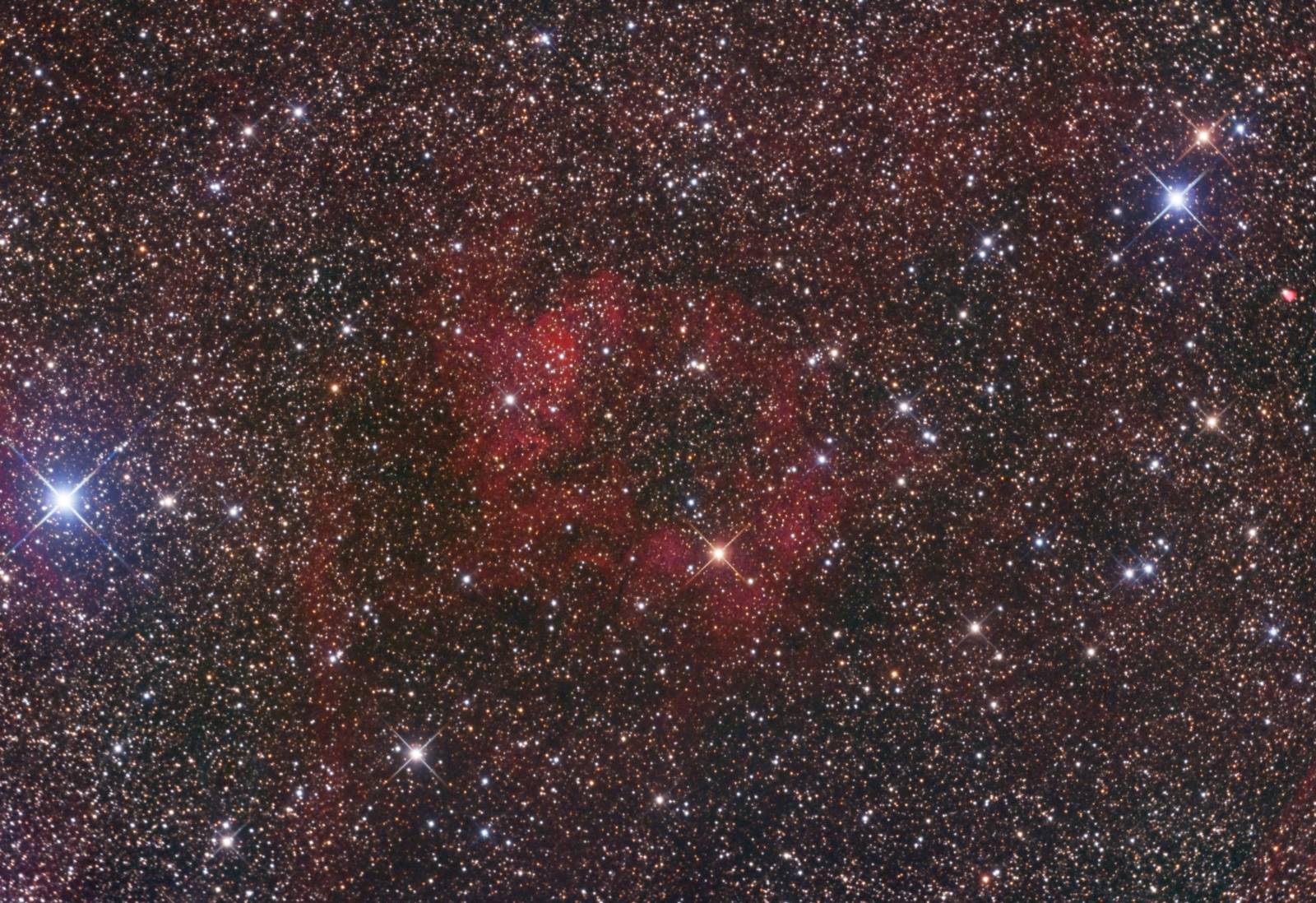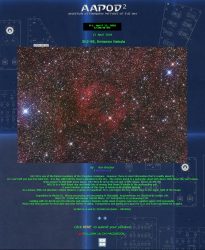Sh2-98 Emission Nebula (Colour)
 Click image for full size version
Click image for full size version
April 14, 2017, Amateur Astronomy Picture of the Day April 13, 2018
 Sh2-98 is one of the fainter members of the Sharpless catalogue. However, there is scant information that is readily about it, so I can’t tell you just how faint it is. It is big, with half the Moon’s diameter in the sky. The cosmic donut is a molecular cloud with about 3000 times the Sun’s mass, lying around 12,000 light years away. Sh2-98 is lit up by the red star in the nebula, known as WR130. WR130 is a Wolf-Rayet star and emits lots of energy that blows a bubble in the surrounding gas. A more familiar example of this type of nebula is the Bubble Nebula. As a bonus, little red planetary nebula Henize1-4 glows at magnitude 10.5, just below the two bright stars to the upper right of the image.
Sh2-98 is one of the fainter members of the Sharpless catalogue. However, there is scant information that is readily about it, so I can’t tell you just how faint it is. It is big, with half the Moon’s diameter in the sky. The cosmic donut is a molecular cloud with about 3000 times the Sun’s mass, lying around 12,000 light years away. Sh2-98 is lit up by the red star in the nebula, known as WR130. WR130 is a Wolf-Rayet star and emits lots of energy that blows a bubble in the surrounding gas. A more familiar example of this type of nebula is the Bubble Nebula. As a bonus, little red planetary nebula Henize1-4 glows at magnitude 10.5, just below the two bright stars to the upper right of the image.
This light for this image was captured during late summer 2014, and reprocessed in 2017. It shows that imaging is possible with narrowband filters under a nearly full moon. The Ha data were acquired under a nearly full moon (the Ha image is here). See my article on imaging in moonlight for more information.
I haven’t seen a common name for Sh2-98, but given its appearance I propose we call it the Donut Nebula.
Tekkies:
Acquisition in Maxim DL. All pre-processing and processing in PixInsight. Acquired from my SkyShed in Guelph, ON. SBIG STL-11000 with Baader HaRGB filters. 10″ ASA @ f/6.8 on a Paramount MX. Guiding with SV-80 80 mm f/6 refractor and camera’s Remote Guide Head. Imaging runs were scripted using CCDCommander. Moon near first quarter for RGB data and near full for H-alpha. Transparency and seeing very good for R, G and B and excellent for H-alpha.
6x10m R, G and B; 23x20m Ha (total – 10hr40m)
NB-RGB Creation
Creation and cleanup: R, G, B and Ha masters were cropped and processed separately with DBE. R, G and B were combined to make an RGB image which was processed with BackgroundNeutralization. ColorCalibration was applied. The NBRGBCombination script was run using Ha for red narrowband and a scale of 1.2. HistogramTransformation was used to balance the colour channels in the HaRGB image.
Linear Noise Reduction: MultiscaleLinearTransform was used to reduce noise in the background areas of the NB-RGB file. Layer settings for threshold and strength: Layer 1: 3.0, 0.6 Layer 2: 2.0, 0.45 Layer 3: 1.5, 0.33 Layer 4: 1.0, 0.2 and Layer 5: 0.5, 0.13
Stretching: HistogramTransformation was applied to make a bright, pleasing image.
Synthetic Luminance:
Creation and cleanup of SynthL: The cleaned up Ha, R, G and B masters were combined using the ImageIntegration tool (average, additive with scaling, noise evaluation, iterative K-sigma / biweight midvariance, no pixel rejection).
Deconvolution: A star mask was made to use as a local deringing support. A copy of the image was stretched to use as a range mask. Deconvolution was applied (80 iterations, regularized Richardson-Lucy, external PSF made using DynamicPSF tool with about 25 stars).
Linear Noise Reduction: MultiscaleLinearTransform was used with internal Linear Mask to reduce noise in the background areas. Layer settings for threshold and strength: Layer 1: 3.0, 0.9 Layer 2: 2.5, 0.8 Layer 3: 2, 0.7 Layer 4: 1.5, 0.6 Layer 5: 1, 0.25
Stretching: HistogramTransformation was applied to make a bright, pleasing image.
Noise Reduction and Re-Stretch: TGVDenoise was applied in Lab mode with 300 iterations (convergence set on at default setting) with a range mask used to protect high signal areas. This was followed by a HistogramTransformation to raise the black point.
Combining SynthL with NB-RGB:
The processed SynthL was applied to the NB-RGB image using LRGBCombine.
Additional Processing
Final Steps: MultiscaleLinearTransform was used to sharpen the structures in the bright parts of the nebula (layers 2-4 at 0.05), followed by a pass of TGVDenoise on the L channel only, using default settings. Background, nebula and star brightness, contrast and saturation were adjusted in several iterations using Curves with masks as required. MorphologicalTransformation was applied to medium sized stars with the Morphological Selection operator (size 3, 3 iterations, amount 0.17, selection 0.23).
Image scale is about 1.1 arcsec per pixel for this camera / telescope combination.






Hi Ron,
Interesting shot – obviously needing a lot of Ha time to dig out the detail!
As usual, your processing notes are invaluable to a Pixinsight learner like me.
Thanks,
Mark
Thanks! Yes, incredibly faint. Glad you find the processing tips helpful!
Clear skies,
Ron
It’s so great to see this imaged and that planetary nebula is delightful! The only things that could make this image better are narrower 3nm filters and exposures taken without the moon in the sky.